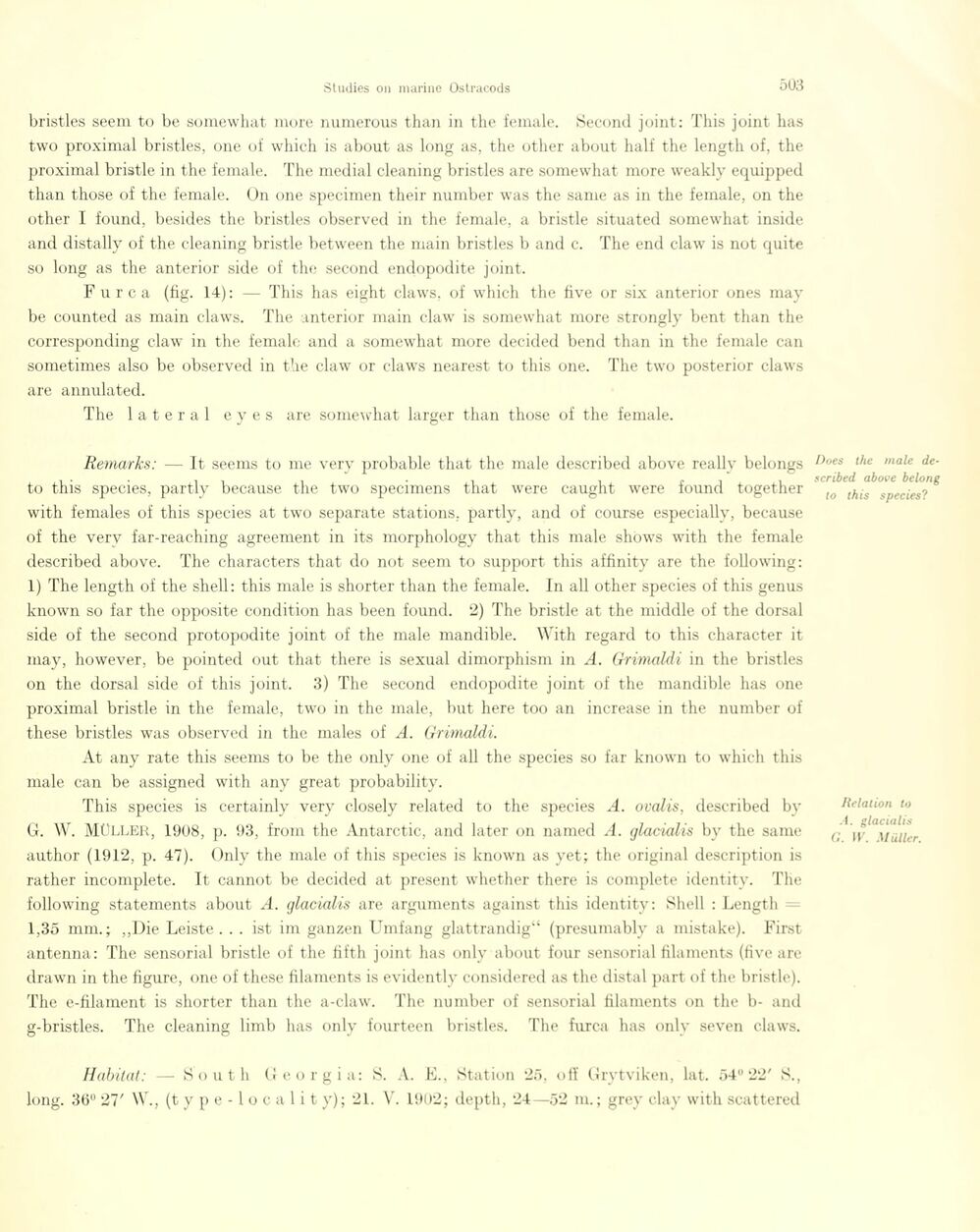
Full resolution (JPEG) - On this page / på denna sida - Sidor ...

<< prev. page << föreg. sida << >> nästa sida >> next page >>
Below is the raw OCR text
from the above scanned image.
Do you see an error? Proofread the page now!
Här nedan syns maskintolkade texten från faksimilbilden ovan.
Ser du något fel? Korrekturläs sidan nu!
This page has never been proofread. / Denna sida har aldrig korrekturlästs.
bristles seem to be somewhat more numerous than in the female. Second joint: This joint has
two proximal bristles, one of which is about as long as, the other about half the length of, the
proximal bristle in the female. The medial eleaning bristles are somewhat more weakly equipped
than those of the female. On one specimen their number was the same as in the female, on the
other I found, besides the bristles observed in the female, a bristle situated somewhat inside
and distally of the eleaning bristle between the main bristles b and c. The end claw is not quite
so long as the anterior side of the second endopodite joint.
Furca (fig. 14) : — This has eight claws, of which the five or six anterior ones may
be counted as main claws. The anterior main claw is somewhat more strongly bent than the
corresponding claw in the female and a somewhat more decided bend than in the female can
sometimes also be observed in the claw or claws nearest to this one. The two posterior claws
are annulated.
The lateral eyes are somewhat larger than those of the female.
Remarks: — It seems to me very probable that the male described above really belongs
to this species, partly because the two specimens that were caught were found together
with females of this species at two separate stations, partly, and of course especially, because
of the very far-reaching agreement in its morphology that this male shows with the female
described above. The characters that do not seem to support this affinity are the following:
1) The length of the shell: this male is shorter than the female. In all other species of this genus
known so far the opposite condition has been found. 2) The bristle at the middle of the dorsal
side of the second protopodite joint of the male mandible. With regard to this character it
may, however, be pointed out that there is sexual dimorphism in A. Grimaldi in the bristles
on the dorsal side of this joint. 3) The second endopodite joint of the mandible has one
proximal bristle in the female, two in the male, but here too an inerease in the number of
these bristles was observed in the males of A. Grimaldi.
At any rate this seems to be the only one of all the species so far known to which this
male can be assigned with any great probability.
This species is certainly very closely related to the species A. ovalis, described by
G. W. Müller, 1908, p. 93, from the Antarctic, and later on narned A. glacialis by the same
author (1912, p. 47). Only the male of this species is known as yet; the original description is
rather incomplete. It cannot be decided at present whether there is complete identitv. The
following statements about A. glacialis are arguments against this identity: Shell : Length
1,35 mm.; „Die Leiste. . . ist im ganzen Umfang glattrandig“ (presumably a mistake). First
antenna: The sensoria! bristle of the fifth joint has only about four sensorial filaments (five are
drawn in the figure, one of these filaments is evidently considered as the distal part of the bristle).
The e-filament is shorter than the a-claw. The number of sensorial filaments on the b- and
g-bristles. The eleaning limb has only fourteen bristles. The furca has only seven claws.
Habitat: — South Georgia: S. A. K., Station 25, off Grytviken, lat. 54°22’ S.,
long. 36° 27’ W., (type-localit y); 21. V. 1902; depth, 24—52 m. ; grey clay with scattered
Does the male
described above belong
lo this species?
Relation to
A. glacialis
G. IL. Muller.
<< prev. page << föreg. sida << >> nästa sida >> next page >>